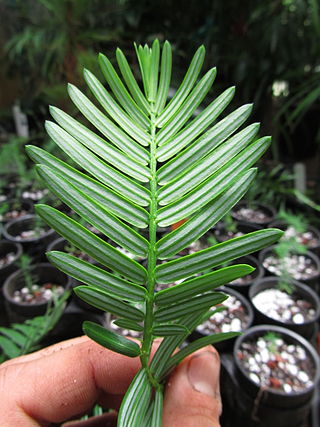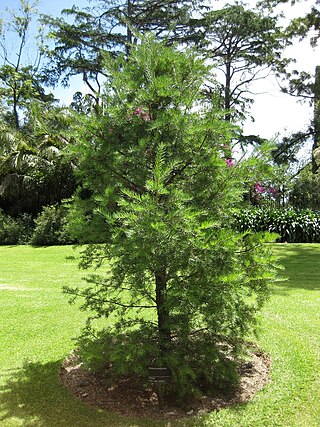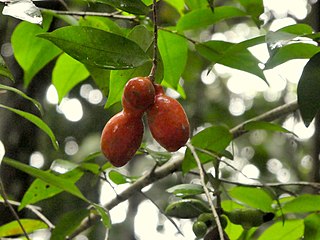
Cephalotaxus mannii is a species of plant in the family Taxaceae. It is a tree up to about 20 metres (66 ft) tall, native to southern China, northeast India, Laos, northern Thailand, northern Myanmar and northern Vietnam. While the species is widespread, its populations are fragmented and it is threatened by cutting for timber as well as for using its bark and leaves for medicinal extracts.
Cephalotaxus hainanensis is a species of conifer known by the common name Hainan plum-yew. It is native to southern China, southeastern Tibet, and Myanmar, Thailand, and Vietnam in northern Indochina.

Keteleeria evelyniana is a species of conifer native to southern China, Laos and Vietnam. It can grow to a height of 40 metres (130 ft).
Firmiana hainanensis is a species of flowering plant in the family Malvaceae. It is found only in China. It is threatened by habitat loss.

Chuniophoenix hainanensis, also known as Hainan fan palm, is a species of palm tree. It is endemic to China.
Leptobrachium hainanense, the Hainan pseudomoustache toad, is a species of amphibian in the family Megophryidae. It is endemic to the mountains of central and southwestern Hainan Island, China. Before being recognized as a separate species, it was confused with Leptobrachium hasseltii.
Alseodaphnopsis hainanensis is a species of plant in the family Lauraceae. It is found in Hainan and northern Vietnam. It is threatened by habitat loss.
Aristolochia hainanensis is a species of plant in the family Aristolochiaceae. It is endemic to China.
Begonia hainanensis is a species of plant in the family Begoniaceae. It is endemic to China. It grows in forests and on mossy rocks.
Gmelina hainanensis is a species of tree in the family Lamiaceae. It is a medium-sized tree, up to 15 metres (49 ft) tall, growing on open grassy hillsides and sparse forests. It is found in southern China and in Vietnam.

Helicia is a genus of 110 species of trees and shrubs, constituting part of the plant family Proteaceae. They grow naturally in rainforests throughout tropical South and Southeast Asia, including India, Sri Lanka, Indochina, Peninsular Malaysia to New Guinea and as far south as New South Wales.
Hydnocarpus hainanensis is a species of plant in the Achariaceae family. It is found in China and Vietnam. It is threatened by habitat loss.
Madhuca hainanensis is a species of plant in the family Sapotaceae. It is endemic to China. It is threatened by habitat loss.
Paranephelium hainanensis is a species of plant in the family Sapindaceae. It is endemic to China. It is threatened by habitat loss.
Friesodielsia hainanensis, synonym Richella hainanensis, is a species of plant in the Annonaceae family, native to Hainan. It was first described in 1964. In 2004, it was assessed as "vulnerable"; in 2022, it was listed by Plants of the World Online as "extinct".
Sonneratia hainanensis, the Hainan sonneratia, is a species of plant in the family Lythraceae.

Meiogyne is a genus of flowering plants with 38 species belonging to the family Annonaceae. It is native from southwestern India and Indochina to Australia, including Fiji and New Caledonia. The type species is Meiogyne virgata.
Meiogyne laddiana is a species of plant in the family Annonaceae, first described by Albert Charles Smith in 1936 as Polyalthia laddiana. It is endemic to Fiji.

Meiogyne cylindrocarpa, commonly known as fingersop or native apricot in Australia, is a small tree or shrub in the custard apple family Annonaceae, native to parts of tropical Asia and Australasia.
Vincetoxicum hainanense is a species of plants in the Apocynaceae. It was first described in 1941 as Merrillanthus hainanensis, which was the only species in the genus Merrillanthus.






